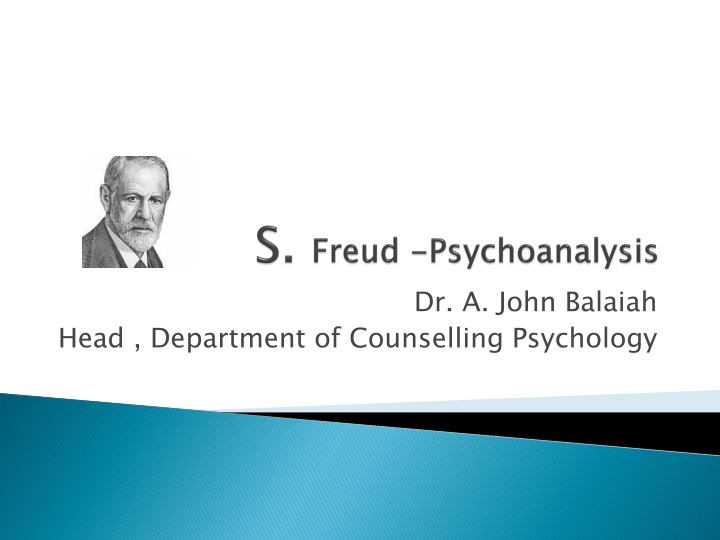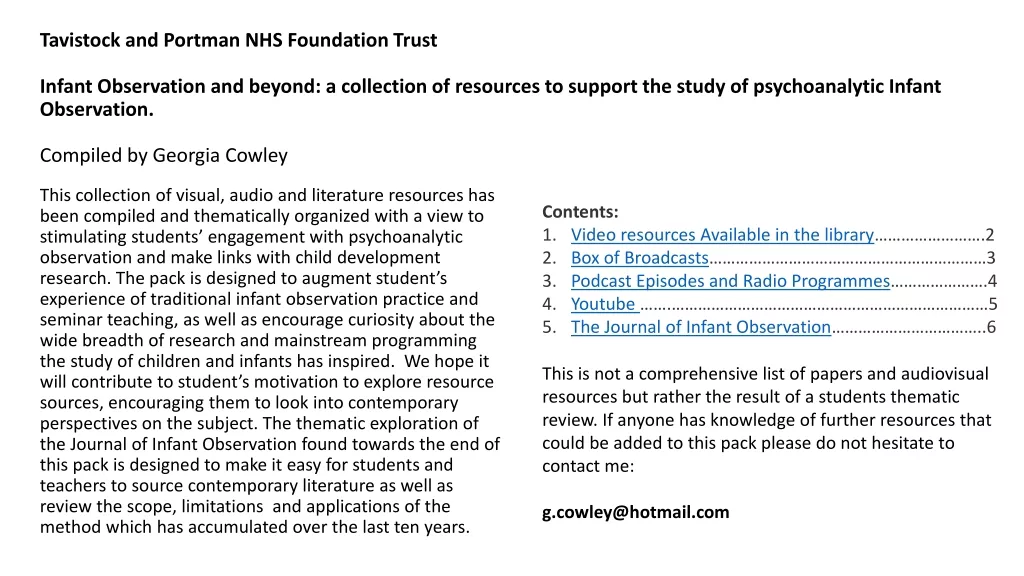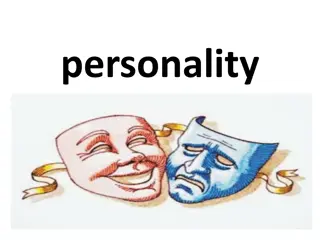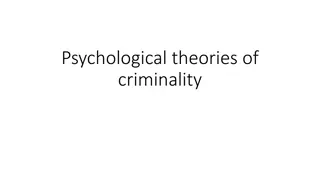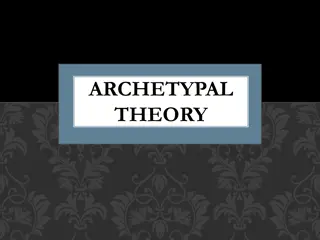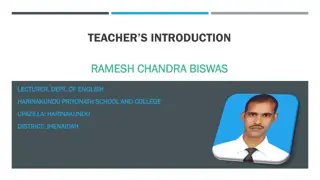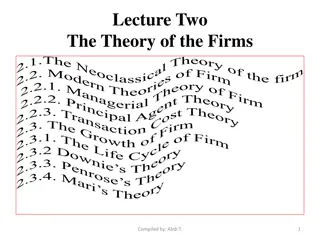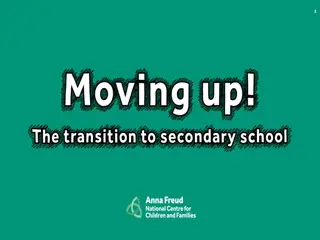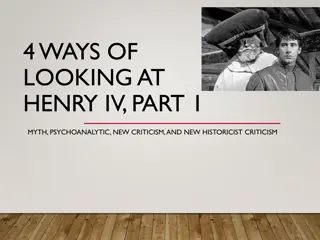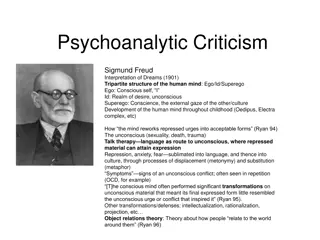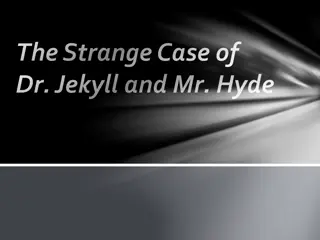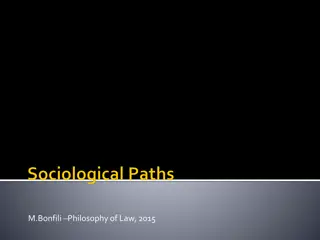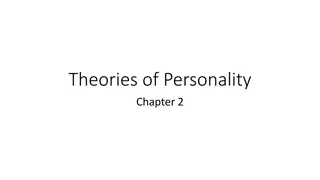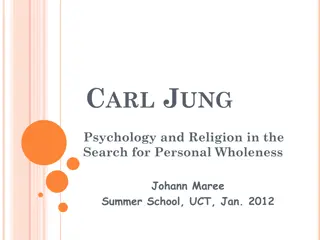Freud's Psychoanalytic Theory
Components of Freud's psychoanalytic theory, including the structure of personality, aggressive and sexual drives, and the influence of unconscious forces on human behavior. Learn about the ID, EGO, SUPER EGO, and how they shape individuals' thoughts and actions based on primal instincts and social influences.
Download Presentation

Please find below an Image/Link to download the presentation.
The content on the website is provided AS IS for your information and personal use only. It may not be sold, licensed, or shared on other websites without obtaining consent from the author.If you encounter any issues during the download, it is possible that the publisher has removed the file from their server.
You are allowed to download the files provided on this website for personal or commercial use, subject to the condition that they are used lawfully. All files are the property of their respective owners.
The content on the website is provided AS IS for your information and personal use only. It may not be sold, licensed, or shared on other websites without obtaining consent from the author.
E N D
Presentation Transcript
Dr. A. John Balaiah Head , Department of Counselling Psychology
View of human nature Deterministic Behaviour is determined by unconscious forces, unconscious motivations, biological and instinctual drives These evolve through key psychosexual stages in the first six years PA teaches , one may through insight free oneself from the tyranny of past experiences
Central Life insinticts Libido to sexual energy Broadened to include the energy of all life instincts Serve the purpose of the survival Libido- source of motivation that encompasses sexual energy but goes beyond it Goal of life- gaining pleasure and avoiding pain
Aggressive drives Unconscious wish to die or hurt themselves or others Sexual drives and aggressive drives are powerful determinants Why people act as they do Conflicts between LI (Eros) and death instincts ( known as Thanatos) How to manage aggressive drive ( Civilization and its discontents) Human race can be exterminated How much more true is this today that in Freud s time
1. Structure of personality 2. Topographic model
Personality consists of three systems The ID, EGO & SUPER EGO Psychological structures and not manikins Personality functions as a whole No three discrete segments ID- Biological component, Ego Psychological component & Super EGO- Social component
ID At birth all ID EGO Contact with the external world of reality Executive Body Executive, governs , controls and regulates the personality Traffic Cop- mediates between instincts and the surrounding environment Controls consciousness and exercises censorship Plans how to satisfy the needs Seat of intelligence and rationality Checks and balances the blind impulses of the id Id knows the subjective reality, ego distinguishes EGO SUPER EGO Judicial Moral code Good/bad; right/wrong Ideal than real No pleasure but perfection Traditional values Inhibit the Id impulses To persuade the Ego to strive for moral goals than realistic goals Internalization Promotes rewards and punishments Rewards are feelings of pride and self love Punishments are feelings of guilt and inferiority SUPER EGO Primary Source of Psychic Energy & seat of instincts Blind, demanding and insistent Lacks organization Discharges tension immediately and returns to homeostatic condition Pleasure principal Illogical, amoral and to satisfy instinctual needs ID never matures, It does not think but wishes and acts
Unconscious cannot be studied directly In has to be inferred directly from the behaviour Clinical evidence for postulating the unconscious include the following 1. Dreams : symbolic representations of unconscious needs , wishes and conflicts 2.Slips of the tongue and forgetting ( Familiar name) 3.Posthypnotic suggestions 4. Material derived from free association techniques 5. Material derived from projective techniques 6.Symbolic contents of psychotic symptoms
Contains ideas , feelings and memories available to us when we choose to focus attention on them. E.g. Nuclear war Primary function is to police our psyche and prevent unconscious thoughts that might generate anxiety from reaching consciousness Either completely blocks unconsciousness or disguising unconsciousness material Incestuous impulses arouse anxiety represses hatred / Reaction formation Sexual impulses are buried in her unconsciousness ( Boy in love with a girl)
1. Secondary process- (Consciouness & PC) Reality principle, logical and organized Normal mode of thinking 2. Primary Process unorganized mental activity unconscious, no logic appears 5 years but a college student ( Dream) Certain mechanisms are operative
Smbolism An object to signify something else based on its original and substiture Banana, Papaya Condensation- Several objects come fused in a single symbol ( one s boss, father, minister appear as the same person in the dream) Displacement Emotions, ideas and wishes are transferred from their original substitute ( Anger might be displaced from a parent to a teacher)
Thin slice of the total mind Larger part of the mind exists below the surface of the water ( awareness) Unconscious stares up all experiences, memories, repressed materials. Needs and motivations are inaccessible ( out of awareness) ( absentia in the world of unconscious)
Aim of psychoanalysis is to make the unconscious , conscious Then only one can exercise choice ( Therefore, Indecisiveness) Essential to grasp the role of unconscious in the understanding of psychoanalytic model of behaviour Unconscious influence behaviour Unconscious processes are the roots of all forms of neurotic symptoms and behaviours Cure is uncovering the meaning of the symptoms , causes of the behaviour and the repressed material that interfere with healthy functioning Intellectual insight alone does not resolve the symptoms Old patterns (repetition) must be confronted through transference distortions.
State of tension that motivates us to do something Develops out of conflict between the psychic structure Function- to warn the impending danger Reality anxiety Proportionate to the danger in the external world Neurotic anxiety- is the fear that the instincts will get out of control and do something, may invite punishment Moral anxiety- fear of one s own conscience When ego cannot manage anxiety by rational or direct methods, it relies on unrealistic ones- Ego Defense mechanism
Immature Repression Denial Retroflection Acting out Projection Splitting Reaction Formation Conversion/Somatization Dissociation Displacement Intellectualization Isolation
Altruism Humour Suppression Anticipation Sublimation
Repression Forcing the thoughts, memories and feelings into the unconscious Responsible for lapses of memory Accompanied by symbolic behaviour (Clothes selection- Man attracted to a female psychiatrist) Denial Unacceptable thoughts banished from awareness ( Physical disorders) Repression : Akin to forgetting
Retroflextion Turning against the self Deflecting it from original object to self Depressive & masochistic Hypochondriasis transoforming a reproach towards others into somatic complaints Retroflextion Hypochondriasis- Retroflextion involves
Acting out Acting on an unconscious wish Psychologists disapprove of Projections: To defend one s own unresolved feelings ( Advancing behaviours- Everyone in the streets) Acting out- - acting on an intolerable feelings
Spilting- Dissociating positive and negative aspects and compartmentalizing Good guys and bad guys Living with ambivelances Reaction Formation: Unconscious impulses are disallowed and opposit conscious attitudes and behaviours are developed Woman who despises her children Undue affection Using salacious literature in schools and colleges Voluntines Day
Conversion Symbolically expressed through body Expressed through bodily symptom Woman whose unacceptable impulse to kill her husband becomes paralysed Conversion- Somatoform disorder Dissociation: To avoid or cope with severe emotional stress Sleep walking, amnesia and multiple personality
Displacement Redirects feelings from an original object to a more acceptable or less dangerous substitute Displacement Intellectualization To avoid strong feelings ( Not in our hands) Thinking about instinctual wishes in affectively bland terms to avoid experiencing strong emotions ( Not getting a position- Don t deserve it) Intellectualization
Isolation of affect Separation of feelings from an idea Banishing into consciousness Obsessive compulsive personality styles (Husband who is angry with wife may not express her anger, but finding out ways to hurt her) Isolation of affect
Altruism Instinctual and gratifying service to others Philanthropy or public service ( Unlike Reaction formation) Humor comic fashion Suppression paying attention to an unpleasant subject Minimising misfortunes Keeping a stiff upper lip I ll think about that tomorrow Altruism Humor- Forbidden wishes can be expressed in Suppression- - Conscious effort to postpone
Anticipation a realistic fashion to decrease anxiety Impending separation from a loved one Anticipation- - Planning for a future discomfort in Sublimation Sexual & aggressive impulses into personally and socially acceptable channels. Sports, aggression is tamed Aggression is channelled but not inhibited Many artistic endeavours sublimated libidinal energies Sublimation- supports much of civilization
Three early stages of development usually people bring to counseling Gratification Vs. Deprivation Stage 1 : Oral stage Libido Pleasure -Zone Oral gratification- Trust, Accepting other, forming interpersonal relationships Oral fixation: Mistrust, rejection, inability form relationships Mental Health issues ( Borderline personality disorder, paranoia, Addictions to alcohol )
ORAL INCORPORATIVE BEHAVIOUR Stimulation of the Mouth then it is developed to the other parts of the body Adults who exhibit ( excessive eating, chewing, talking ,smoking and drinking) Due to oral fixation Deprivation during infancy is assumed to lead problems into adulthood
Oral aggressive period- while the infant teeths Adult Characteristics- Sarcasm, hostility, aggression, gossip and making teething comments are related to events of this developmental period Greediness and acquisitiveness- not enough getting food or love Material things are substitutes for what they really want food and love Mistrust , fear of reaching out to others, rejection of affection , fear of loving , low self esteem, isolation and withdrawal and inability to form /maintain relationships
Stage 2: Anal Stage: Zone (1-3) Learning independence, accepting personal power, learning to express feelings such as rage and aggression ( negative feelings) Control over the bowels- Far reaching effects on their personality traits Parental discipline and attitudes have significant consequences for child s later personality development- OCD, Phobia
Children also exercise their power Withholding their feces or defecating at inappropriate times Strict toilet training resulting in inappropriae places and times Later adulthood characteristics like cruelty, anger and extreme disorderliness- anal aggressive personality Parents praise Importance of this activity Need for productivity Child will develop lot of negative feelings
Adults develop fixation revolving around extreme orderliness, hoarding, stubbornness and stinginess This is known as anal-retentive personality Accept anger and hostility towards those who love These feelings were bad and parental acceptance would be withheld if they expressed, so they repressed Do this here/there Lost touch with potential for power Struggle to define who they are and what they are capable of. Accept anger and hostility towards those who love
Phallic Stage : Genitalia as the erogenous zone- Libido centers- Basic conflicts center around unconscious incestuous relationship Oedipus complex- Male Phallic stage Parent of opposite sex because of threatening nature , repressed Girls- Electra Complex Possess the parent of the opposite sex comes the wish to do away with the competition- of the same sex How the parents respond verbally and nonverbally has an impact on sexual attitudes and feelings that child develops
Boy in fantasy and in behaviour exhibits sexual longing for the boy More powerful the father rival repression has already begun Specific fears- Castration anxiety- Cut off Fear is increased when he sees the absence of penis in the girls Fear of losing his prized possession Represses his longings for the mother If he cannot beat him rather join him More acceptable forms of affection Vicarious satisfaction Becomes more like his father, adopt many of his father s mannerisms
Many controversies regarding female phallic stage Girls first object of love is mother , but love is transferred to the father She develops negatives feelings especially when she observes the absence of a penis, condition known as penis envy Compete with the mother for father s attention Penis envy is girl s counterpart to the boy s castration anxiety
Sexuality is misunderstood Sexuality refers to organ pleasure of any kind Sexuality is more diffused- Not meaning the sexual act Curiosity about sex is aroused Sex role identification is the developmental task
All the above three stages- narcissistic- self centeredness inner world Moving to External reality Quiescent interests are developed after the torment of sexual impulses of preceding years Sexual interests are replaced by school, play mates, sports and range of new activities Time of socialization Towards forming relationships with others
Old themes of phallic stage are revived Though there are societal restrictions and taboos adolescents can deal with socially acceptable activities Turning away from narcissistic to Altrusitic Goals of lieben und arbeiten To love and work Loving and working bring paramount satisfaction and derive satisfaction
Core characteristics of mature adult is the freedom to love and work. Freedom from parental influence and capacity to care for others
Goals 1. Make the unconscious conscious 2. Strengthen the ego so that the behaviour is based more on reality and less on instinctual cravings 3, Childhood experiences are reconstructed, discussed , interpreted and analyzed 4. Oriented toward achieving insight, not just intellectual understanding but with feelings and memories associated with this self understanding
Blank screen approach Ananymous Neutral Transference relationships which will foster projections on them Significant other of the client Grist for the mill Who is a healthy person?
Analyst listens while Analysand does most of the talking To teach clients the meaning of these processes Analysand's feelings toward the therapist It is more like putting the pieces together
Long term commitment Three to five years Lying on a couch encourages deep and uncensored reflections Fosters projections (Classical ) Root causes of their historical problems No Radical decisions Insight into how environments affect them and how they affect the environment and a reduced defensiveness
Transference is the core Transference allows clients to understand and resolve unresolved business from these past relationships. Current substitute for significant others Positive transference towards the therapist
Working-through Process Not only become aware of unconscious material but also achieve some level of freedom from infantile strivings total love and acceptance from parental figures Narcissistic disorders may improve with repeated acknowledgements of the past
Learn to provide themselves with reassurances rather than seeking confirmations from the others Notion of never becoming completely free of past experiences has significant implications for the therapist May lead to counter transference- Dependence tendency
1. Maintaining the Analytic framework Talk Catharsis- Insight- working through the unconscious material Analyst s relative anonymity, regularity, consistency of meetings, starting and ending of sessions (Feeding an infant) Minimise departures
Saying whatever comes to mind Basic rule Painful, silly, trivial, illogical, irrelevant Central technique, No censorship Lie on the couch (Classical) Surface content, hidden meaning Listening with the third ear Areas that clients do not discuss are more significant Client must determine the actual meaning
1. pointing out the meanings of free association, resistances, dreams, therapeutic relationships Ego to assimilate the new material Therapist uses clients reactions as gauge 2.Interpretation should always start from the surface 3. Point out a resistance / Defense
Dreams are royal road to unconsciousness Two levels Latent content hidden, symbolic, unconscious motives, sexual and aggressive impulses are transformed into Manifest Content Unlock repression that has kept from consciousness and relate it to the present struggle Understanding to the current functioning
